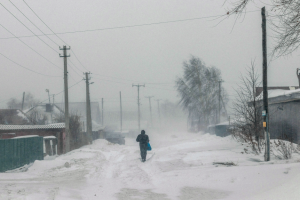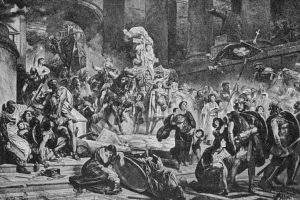The United States’ immigration system is, as Alejandra Oliva writes, “hungry for bodies to suffer.” In her book, Rivermouth: A Chronicle of Language, Faith, and Migration (Astra House), the Mexican American translator and immigration justice activist draws on her experience as a volunteer interpreter for people crossing the U.S.-Mexico border and seeking asylum, weaving together insights on immigration justice, faith, and translation theory.
Although the book covers the years 2017 to 2020, “it’s still, unfortunately, extremely relevant,” Oliva says. “The ways in which it’s gotten less relevant are usually because the situation is worse, not better.” She began writing Rivermouth while in divinity school, “around the time that Trump officials were using Bible verses to justify deportation,” she says.
Today, as immigrants remain under attack and the government arrests and deports people without cause or due process, Oliva’s sharp insights—on ICE detention centers, the consequences of U.S. intervention in Latin America, the exploitation of farmworkers, and the injustices embedded in our food system—help readers grasp the full scope of the crisis and how we arrived at our current situation. “Nothing has made me angrier at God, or believe in God less, than watching people go through the immigration system,” she says.
In the face of human rights abuses, Oliva challenges readers to embody a bold solidarity that insists—despite everything the American empire wants us to believe—that we are responsible for one another.
What led you to write Rivermouth?
I started volunteering as a translator with New Sanctuary Coalition in New York City in early 2017. A lot of the work was sitting across the table from people, asking them to tell me the worst things that had ever happened to them—horrifying traumas. Then I would take their answers, which were often rich and detailed, and chop them into tiny pieces, pulling out the most legally salient parts for their asylum application forms.
I did that work for less than a year, then I went to divinity school. While there, I read a lot of translation theory and thought about what it means to care for others and what we owe to one another.
I also did court observation with Boston Immigrant Justice Accompaniment Network. Usually someone on the docket asked for additional observers, which helps hold judges accountable. We’d sit and watch people on Zoom during immigration cases from Boston-area detention centers—5-, 10-, 20-minute hearings, one after another. Each person on their own pipeline to deportation, talking about their family, what got them arrested. I saw how repetitive it is—how the system just chews people up.
During this time, while I was in grad school, I also visited the border in Tijuana around the 2018 midterms, when the migrant caravan, which had left Honduras in October 2018 and grew to as many as 7,000 people as it approached the United States, was arriving at the border. By early 2019, many people who had migrated with the caravan were stuck in Tijuana looking for information about what was waiting for them when they crossed the border into the United States. Two weeks after I left, the United States began the Remain in Mexico policy. Officially known as the Migrant Protection Protocols, this policy required asylum-seekers to stay in Mexico until their immigration hearing in the United States.
After graduating, I moved to Chicago and worked at the National Immigrant Justice Center. I visited a detention center in the Southeast and reported on the facilities that opened under the first Trump administration. I talked to people there: Some people were grateful to have a roof over their heads and meals, while others felt like it was a prison.
Your book also includes a discussion of food justice, on top of your writing on immigration. In this section, you include a reflection about the Eucharist. What is the connection between the Eucharist and food justice?
We can think of all the food we eat as a kind of sacrament—it sustains us and brings renewed life. But that gets messy when we consider where 95 percent of our food comes from. Your mom may have cooked it, but where did the ingredients come from? At what point does it stop being a labor of love and start being a labor of capitalism and exploitation?
Bread is this very mundane thing that many of us eat all the time every day. It’s our daily bread. It’s a subject worthy of consideration: where it comes from and who else’s body is being sacrificed in order to make this daily sustenance.
That’s not to discount the Eucharist or glorify all food. So much of our food system here, and globally, depends on immigrant labor. It felt important to talk about food justice—and also about the Eucharist, which is both mundane and holy.
The Rio Grande is an important metaphor in your book that represents both language and borders. Does this have anything to do with the challenges of dealing with language and translation in immigration justice work?
The Rio Grande is a river of two names. Here in the United States, we call it the Rio Grande, and in Mexico they call it El Rio Bravo—the “Whitewater River.” It has this sense of power and anger. It’s very turbulent. Language moves in similar ways—slippery, complicated, shared—it’s something you can’t totally wrap your arms around by yourself.
One thing I want to suggest is not thinking of a river as a dividing line, but as a place of opportunity, where it’s OK to splash around and mess up. I think that’s true of language, too.
If you’re raised as monolingual or pick up a second language later, you see boundaries between languages as stark and divided. If you grow up speaking multiple languages, you play with language differently—it’s more collaborative and cross-cultural.
Google Translate makes it seem like translation is straightforward, but it’s really a series of decisions. Do I transmit the tone or the exact words? How much context do I give so the reader understands? How much can I change to make it more palatable or legible to someone from a different culture? There’s a whole decision-making matrix, and different schools of translation guide you differently.
A lot of Western, Christian-based translation theories focus on honoring the source text. These traditions come out of the tradition of translating scripture and honoring the divinity in words. They also tend to assume everyone’s on the same playing field, which often isn’t true.
In the middle of translating someone’s story for an asylum application, I am an intermediary between an asylum-seeker, who has very little power, and the entity that has the most power in the world—the U.S. government.
Am I honoring an asylum-seeker’s story, or am I having to dishonor it to accommodate the forms of speech the U.S. government recognizes as valid? In what ways do I take the parts of a person’s story that feel shameful or traumatic and manipulate them to fit the narrative the government is looking for in an asylum case? You never lie, obviously, but you sometimes have to shift the emphasis from the way the story was told to you.
You sometimes leave out things that feel very important to the person telling the story but don’t carry weight legally. Despite some training as a translator, I felt very much at sea doing this work.
You write that while the U.S. government isn’t the Catholic Church, it still expects asylum-seekers to be saints. How does the asylum process demand this kind of moral perfection?
It used to be that you’d have a “Credible Fear Interview,” where the government asked: Are you scared to go back to your home country? Why?
If you said “no,” or if your reason fell outside asylum law, you’d be deported. In the book, I talk about a man who was scared to return to Haiti because of the constant natural disasters. As credible as that fear is, it doesn’t count for asylum.
If someone’s fear was based on a credible threat of violence, they might get to stay in the United States while their case was processed. They had a year to submit evidence—one that’s expected to follow certain beats, almost like a hagiography: I lived a good life, then this happened, then this, and that’s why I had to come here.
There’s this expectation of purity and straightforwardness that doesn’t match the messy realities of people’s experiences. In Latin America, for example, people are often forced into gangs under threat, then try to leave—usually by fleeing. But having been in a gang can count against you.
I’ve seen people denied asylum because of tattoos seen as gang-related, even if they weren’t. I have plenty of tattoos myself, and I’m very privileged not to have to worry about how they’ll be judged.
How has the United States contributed to the conditions that force people to flee their home countries?
The United States has a long history of interventionism in Latin America, especially during the Cold War. In many countries, wealthy landowners—including companies such as United Fruit Company—controlled large portions of land. When populations elected socialist leaders promising land redistribution to benefit Indigenous and poor people, the United States often backed military coups against these leaders.
This combination of internal conflicts and U.S. intervention led to tragedies such as the Guatemalan Civil War, which became a genocide against Indigenous people, and the “dirty wars” across Central America in the 1980s. During the first sanctuary movement in the ’80s, many people were fleeing those wars.
Today, the children of that generation still face the consequences. Many peace agreements took place in the 1990s, but recovery has been slow and fragile. U.S.-based companies continue economic interventionism, exploiting cheap labor.
In El Salvador, you also have the rise of gangs that have become boogeymen in the United States, like MS-13, which actually began in Los Angeles. The reason that it has taken root in El Salvador is because gang members were deported from Los Angeles.
Many people I talk to say, “I want my children to have a better life than I had. I want them to know what it’s like to grow up safe. I don’t want them to have to worry about violence on their street or against their families.” This is where you feel the consequence of all this interventionism.
Once someone ends up in ICE detention, what do they actually face day-to-day?
People can end up in ICE immigration detention in all kinds of ways. Sometimes it’s a traffic stop. We’re about to see a lot more people detained, because now you can be sent to detention immediately after crossing the border when ICE is not sure what to do with you.
You can also get picked up in a raid or because of a previous criminal charge—even if you’ve already served your sentence. I’ve talked to people who finished their jail time expecting to see their families, only to find ICE agents waiting at the jail doors.
Once you’re in detention, it is a lot like prison. Many of these centers are run by private prison corporations designed to squeeze every last penny from people. You’re usually in a big dormitory with a bunch of other people, usually of your same gender. There’s also ICE family detention, when entire families are detained together.
The food is often bad, moldy, and not nutritious. I’ve heard people talk about watching dormmates go into diabetic shock because they weren’t getting the right levels of sugar. If you arrive with a chronic health condition, it will likely get worse, since medical care is usually poor. Calling your family costs an extortionate amount of money.
It can be really difficult to get an attorney unless someone outside is working hard on your behalf. That’s especially tough, since many detainees are sole or partial breadwinners for their families. Depending on how your court case goes, you might be sent straight from detention to the airport for deportation.
What does solidarity with immigrants look like today?
All of us, quite frankly, are working on figuring out that answer, because things are changing so quickly.
It looks like knowing your rights and knowing your neighbors’ rights. It looks like knowing who to call to report an ICE sighting; not just posting it on Facebook, but knowing what organizations are keeping track and verifying these sightings.
It’s knowing the difference between a judicial warrant and an administrative warrant. It looks like knowing what information you need to get from ICE agents if you see them arresting someone—figuring out how to get badge numbers, how to ask where this person’s being taken, how to film things without getting yourself in trouble. It looks like going and spending money in immigrant neighborhoods.
Chicago is a sanctuary city. Our police department does not collaborate with ICE. Our schoolteachers know their students’ rights and know to keep ICE out of schools. If you don’t live in a community like that, show up at your city council and say, “We need to figure this out, because we have vulnerable people in our community.” Solidarity is figuring out what you need to do to make your community a safer place for folks who might be vulnerable to ICE enforcement actions.
In your book you discuss a Simone Weil essay about attention. Why did this resonate with you as an activist?
This is one of my favorite essays. Weil writes that the same attention you use to do boring algebra homework—that energy of banging your head against the problem over and over until you get a result—is the same energy you use when you pray.
You sit down, fold your hands, and maybe something happens, maybe it doesn’t. Maybe you’re just sitting there quietly for a while and God doesn’t show up. But Weil says if you keep making space, if you keep reaching out toward God, toward understanding algebra, you get to what she calls an “experimental certainty”—it’s going to happen. Something’s going to change in your life if you keep doing these things.
Doing activist work so often feels like that. You think, oh my gosh, all I do is write a stupid little press release asking for more rights. All I do is call my senators. All I do is these little incremental actions that feel like throwing pebbles at a dragon and nothing is changing and what’s even the point.
This essay helps me remember two things: First, that all effort matters—it’s something. Second, the longer and more steadily you do it, the more that you are paying attention to this issue of injustice, the more that you are turning the force of your will on it, you are creating space in which change can happen.
Attention is not enough—you must figure out how to solve the algebra problem. You must figure out what the strategies are. You must be canny about it. But that sustained, often frustrated attention is the thing that gets shit done.
This article also appears in the October 2025 issue of U.S. Catholic (Vol. 90, No. 10, pages 16-20). Click here to subscribe to the magazine.
Image: Courtesy of Alejandra Oliva













Add comment